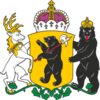Tiskaiya: Difference between revisions
| Line 89: | Line 89: | ||
When Sutranovka united the region, they were given rights to name it. They settled on "Tiskaiya" after there home in the Tikaiskov Valley (Now [[Sutranovan Valley]]). | When Sutranovka united the region, they were given rights to name it. They settled on "Tiskaiya" after there home in the Tikaiskov Valley (Now [[Sutranovan Valley]]). | ||
==Tiskai-Bretislav United Kingdom (970-1048)== | ==Tiskai-Bretislav United Kingdom (970-1048)== | ||
In 970, the | In 970, the Tsar of Tiskaiya ventured west of his lands to conquer the Bretislavian tribes. In the 8 month conquest, Beginning in January and ending in August, he successfully defeated the thirteen tribal kingdoms ruling most of Bretislavia's current lands. The young Tsar would go on to create the Tiskai-Bretislav United Kingdom. This partnership would last 78 years and somewhat thrive during his rule. Creating a united economy and social structure, leading to a mass Tiskai immigration from the dense lands of Tiskaiya to the relatively sparsely populated lands of [[Bretislavia]]. These Tiskaiyans would settle in the southeast of the country closest to their native land of Tiskaiya. To help bypass the language barrier between the early English language and Slavic language, the Tsar would allow each county to have certain freedoms regarding military, education, and other things to avoid confusion. It was only really in the southeast where early English languages were intertwined with Slavic ones. Due to the language barrier and high levels of local bureaucracy, a rivalry would grow in the late years of the Kingdom, becoming a contributing factor to the later war between the two regions. | ||
While the difference in culture was massive, Bretislavian tribes and Tiskaiyans shared a love of militarism and bonded cultures over jousting, dueling, and hunting activities. The combination of these two cultures resulted in a culmination of western and eastern technology and medicines, boosting the countries growth but also serving to hamper it. | While the difference in culture was massive, Bretislavian tribes and Tiskaiyans shared a love of militarism and bonded cultures over jousting, dueling, and hunting activities. The combination of these two cultures resulted in a culmination of western and eastern technology and medicines, boosting the countries growth but also serving to hamper it. | ||
While the Tiskai | While the Tiskai Tsar was benevolent and chivalrous to the Bretislav people, he was still a foreign ruler. He was not the most popular figure, even in newer generations of Bretislavians, who had only known Tiskai leadership since birth. Even with the concessions made to Bretislavians by the Tsar, he never could remove the Bretislavian spirit from the region, leading to harsh military reactions by the Tsar when Bretislavians dissented against his rule and plead for a return of Bretislavian independence. | ||
==Medieval Period== | ==Medieval Period== | ||
Revision as of 18:36, 18 February 2021
This article is incomplete because it is pending further input from participants, or it is a work-in-progress by one author. Please comment on this article's talk page to share your input, comments and questions. Note: To contribute to this article, you may need to seek help from the author(s) of this page. |
The Second Tsardom of Tiskaiya Тискайя | |
|---|---|
| Anthem: Tiskai Sacrifice (Тискайская жертва) | |
| Capital | Oryshevsk |
| Largest city | Pyatidovo |
| Official languages | English, Tiskai |
| Ethnic groups | Tiskaiyans, Bretislavians, Qazhshavans ,Krenyans |
| Religion | Orthodox Christianity |
| Demonym(s) | Tiskaiyan, Tiskai |
| Government | Tsardom |
• Tsar/Czar | Vasily II |
| Legislature | Natsional'nyy Parlament (Национальный Парламент) |
| Establishment | |
• Proclamation of the Kingdom of Tiskaiya | 1492 |
| Population | |
• 2018 census | 82,688,572 |
| GDP (PPP) | estimate |
• Total | 1:1.55 |
| GDP (nominal) | estimate |
• Total | $3,182,000,000,000 |
• Per capita | $38,523.00 |
| Gini | 29.2 low |
| HDI | 0.902 very high |
| Currency | Tratan (TKT) |
| Time zone | -5,-6 |
| Driving side | right |
| Calling code | +7 |
| ISO 3166 code | TSK |
| Internet TLD | .ts |
Etymology and Terminology
When Sutranovka united the region, they were given rights to name it. They settled on "Tiskaiya" after there home in the Tikaiskov Valley (Now Sutranovan Valley).
Tiskai-Bretislav United Kingdom (970-1048)
In 970, the Tsar of Tiskaiya ventured west of his lands to conquer the Bretislavian tribes. In the 8 month conquest, Beginning in January and ending in August, he successfully defeated the thirteen tribal kingdoms ruling most of Bretislavia's current lands. The young Tsar would go on to create the Tiskai-Bretislav United Kingdom. This partnership would last 78 years and somewhat thrive during his rule. Creating a united economy and social structure, leading to a mass Tiskai immigration from the dense lands of Tiskaiya to the relatively sparsely populated lands of Bretislavia. These Tiskaiyans would settle in the southeast of the country closest to their native land of Tiskaiya. To help bypass the language barrier between the early English language and Slavic language, the Tsar would allow each county to have certain freedoms regarding military, education, and other things to avoid confusion. It was only really in the southeast where early English languages were intertwined with Slavic ones. Due to the language barrier and high levels of local bureaucracy, a rivalry would grow in the late years of the Kingdom, becoming a contributing factor to the later war between the two regions.
While the difference in culture was massive, Bretislavian tribes and Tiskaiyans shared a love of militarism and bonded cultures over jousting, dueling, and hunting activities. The combination of these two cultures resulted in a culmination of western and eastern technology and medicines, boosting the countries growth but also serving to hamper it.
While the Tiskai Tsar was benevolent and chivalrous to the Bretislav people, he was still a foreign ruler. He was not the most popular figure, even in newer generations of Bretislavians, who had only known Tiskai leadership since birth. Even with the concessions made to Bretislavians by the Tsar, he never could remove the Bretislavian spirit from the region, leading to harsh military reactions by the Tsar when Bretislavians dissented against his rule and plead for a return of Bretislavian independence.
Medieval Period
Medieval Tiskaiya was a place of competing interests, after the split with the Western Bretislavs, the remaining Tiskaiyans often fought among each other in small conflicts and skirmishes.
1560 - 1790
1560 marked Tiskaiya's race to catch up technologically with the other world powers. By 1680, Tiskaiya was a feat power looking to expand it's influence. Her first targets were the Northern Deserts, the people had hope that should they brave the climate, they would be rewarded with natural resources.
1800 - 1900
This was Tiskaiya's golden age. 5 of Tiskaiya's most prestigious universities were founded during this time. Oryshevsk University, University of Pyatidovo, Trasnaya University, Fedorov University and the University of Novoshi. Literacy rates climbed to 78%, up from 43% in 1725. Tiskaiya adjusted quickly to the industrial revolution and thus cities quickly grew. A sophisticated rail system spread across the Kingdom. Quality Tiskai steel allowed for skyscrapers, and the discovery of oil in the northern desert helped everything run smoothly. Winters during this period were as mild as they have ever been allowing for extended growing seasons. Food was plentiful and people were happy.
Modern Times
Tiskaiya is a nation in Thaudia still trying to find it's feet, with with their old Bretislav allies still there, it is believed that Tiskaiya can become a major player on the continent.

